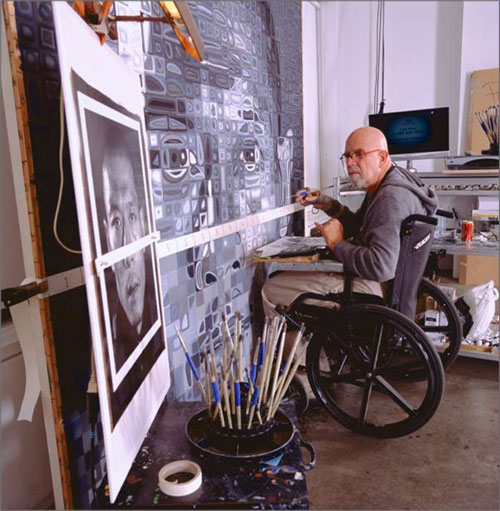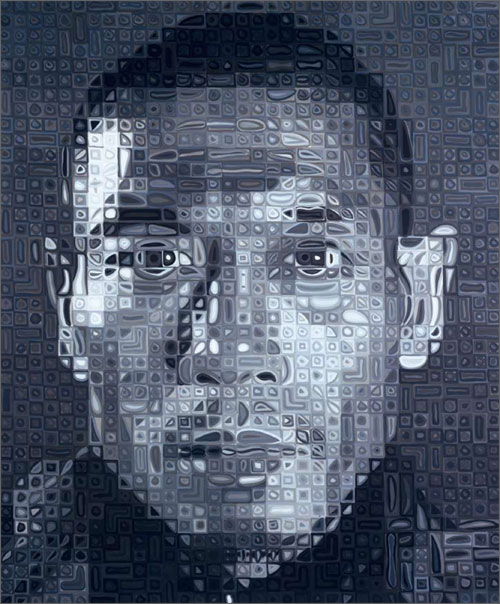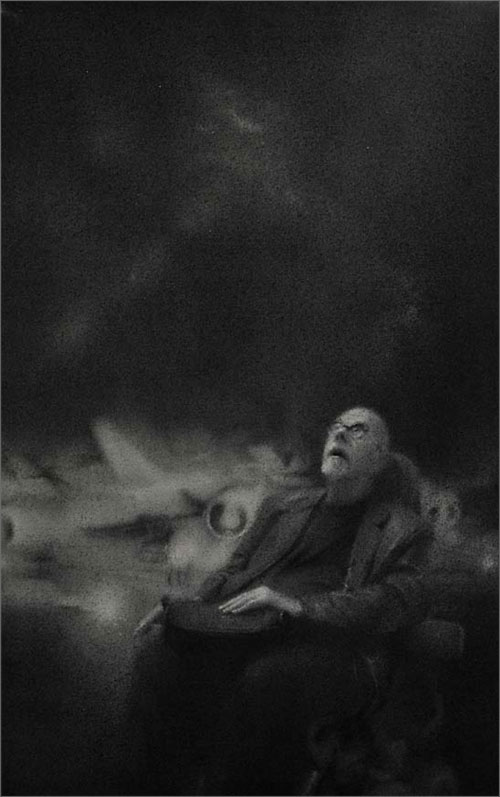|
By Sheri / Pasquarella
tar magazine, Issue Two, Spring 2009, USA
Zhang Huan Stopped by Chuck Close’s New York Studio
to find the painter alone in front of two recently completed portraits. How the two men work suggests canny East-West archetypes:

Chuck Close, 2008, by Michael Marfione
Close --- at 68, probably the most famous living American artist --- the soloist in his painting chamber, as he has worked for four decades; Zhang, the 43-year-old rising star of China, establishing an international carrer, employing the labors of up to a hundred people in the creation of his mixed-media works.
Several months has passed since the two last saw each other. They met in September 2007 during Zhang’s exhibition at the Asia Society in New York. Close already had a worldwide reputation for his pristine portraits of himself and others; Zhang, on the other hand, was building off mid-’90s momentum from his own artistic productions. He made a name first with audacious performance pieces --- in a public bathroom in a Beijing art colony, he coated his naked body in honey for swarms of flies to feast upon him; in New York, he fashioned a bodysuit of raw meat and strode down Fifth Avenue releasing live white doves --- and later by creating art out of ash gathered from Chinese temples. His studio pieces and the photos of his performances --- in Bern, Boston, Rome and beyond --- have embedded Zhang’s image in the global culture consciousness and been exhibited in the Venice Biennale in 1999, the Whitney Biennial in 2002 and at major museums the world over.
On the surfaces of their studio work, differences between the two artists manifest: the bold, slick sheen of a Close painting versus Zhang’s diffusely coarse particles of ash. But surface, of course, is the result of construction and process, and here their similarities enter the story. A good painting has no errant flourishes: Each line or stroke has a job to do, working hard to pull your attention away from its individual efforts and limitations. Thus Close’s meticulous grid-based approach to realism, wherein no single dot or blob can exist without the others that surround it; thus, too, Zhang’s equally exacting technique of deploying tiny unsuspended particles of ether as opposed to trapped particles of paint.
In May 2008, while in New York for his solo show at PaceWildenstein Gallery --- where a scaffolded plank enabled spectators to view a team of Chinese workers assembling a new monumental-scale ash tableau --- Zhang visited Close’s studio for the first time to sit for the photographic portraits the painter would use as templates. When he returned to Shanghai, Zhang began reciprocating his own homage to Close. The results have never before been seen; they debut here in publication. The following is the artists’ re-acquaintance.

Zhang Huan II, 2008-2009, by Chuck Close
ZHANG* [Seeing this work in person] is unexpected. From afar, everything seems so perfect in a way that you can really see the technique, how everything is so refined, polished. But when you get close to the two paintings, you start to see that actually it’s very loose, very free. At the same time, I think it’s almost like calligraphy of the Chinese tradition.
CLOSE That’s interesting, because your language is a pictographic language, so your calligraphy means something. Our Jackson Pollocks, or de Kooning’s "calligraphy" marks, are just tray marks --- they don’t make anything. I think in some ways my stuff is more like calligraphy, but then the marks also have to service the building of an image.
ZHANG If you look at each pixilated cell, you can actually see the elements that are very similar to the Chinese characters of the past. The symbols could be the sun, the moon, the gravestone, the rivers and the fields.
CLOSE to me, the mean hot dogs and donuts. And the occasional penis [laughs]. When I photographed you I did both [color and black-and-white], and it was amazing how close the two photographs are that were taken the same day. So I decided to do the two paintings, the color one with diagonal grid and the black-and-white one with a horizontal/vertical grid. I did the black-and-white painting because of how you build your black-and-white paintings with temple ash. I thought I would like to try to make an image that relates to how you work --- see, you build the painting, rather than paint it. Which is something I feel we really share. I build the painting more than I paint it. I think making a painting is a performance. People just don’t watch the performance. They see the evidence that the performance took place.
ZHANG I completely agree with the process of building the painting, and I do think that this has a performance element to it. In terms of the materials, the ash is actually from the temples around the neighborhood in Shanghai. We don’t say that we "bought" or we "collected" the ashes, because this is not a commodity or something that you can actually buy or collect. This is something that you have to pray for. We pray for ash, and the ash itself embodies all the dreams and wishes of all the people when they are offering their spirits. I particularly like this material just because it is so loaded with meaning. I am forced to interact with yin, the spirits; at the same time, I think it’s almost representing the collective memories of a particular time and place.
CLOSE I think that’s a lovely idea, that embedded in the ashes are all the thoughts and prayers of people. That’s a really touching, wonderful idea. And then [your staff] put it out on the floor and, with tweezers, they pick the ash and abrade it from light to dark, right?
ZHANG When we first pray for the ash to come, it comes with different textures, consistencies --- some completely burned, some half-burned and so on. The first step is to actually separate them in different grades, consistencies, textures and colors. After that, we can do whatever we want with the technique --- either lightly dust the ash off from the brush, or just really bomhard the painting with it.

Chuck Close, 2009, by Zhang Huan
CLOSE When I first saw your work, it was the performance pieces, like those at the Whitney, where you have meat all over your body. And I’d seen this series of photographs that I love [Family Tree, 2002], in which the Chinese characters eventually more or less obliterate your face and make you look like an African-American --- the whole idea of strokes of calligraphy on the face just resonated so much for me. I said, "Oh, I wish I had done that, I wish I had painted brushstrokes on my face." It made me think of how in my work, especially when you get to the diagonal painting --- when the grid is at an angle --- you don’t see the grid as easily. This was the first thing that made me really understand some sort of kinship between our work. Then, of course, the minute I saw the ash paintings and I saw how they were built, it’s so similar to the way I sprayed paint on the early black-and-white paintings --- just little dots of paint hitting the canvas.
ZHANG In my subject matter, the most important part is that this is connected to my memories, in terms of daily life in China. I don’t know these people, but these images are very, very familiar to me. So, that’s the inner dimension that coexists in that particular choice of subject matter. This particular painting I did of you is the first friend that I’ve depicted.
CLOSE I got started trying to paint anonymous people, just everyman, much in the way traditional Chinese portraiture tried to capture the nobility of the everyday person. But as soon as I painted my friends, who happened to be artists like Richard Serra and Philip Glass and whomever, they became famous, so I didn’t have anonymous everyday people anymore. I’ve actually used making a portrait as an opportunity to get to know the person better. I will ask somebody I really don’t know very well at all, but with whom I feel an important relationship through their work. It’s that dialogue that makes me want to paint their portraits; I must really admire their work. I usually just use their first names for the titles, but in your case no one may know "Huan," so I’ll use both names. You’d be the only other person --- besides Bill Clinton --- for whom I used both the first and last names.
ZHANG In China, we always do the last name first, because the idea of the family is the most crucial thing, and therefore you always mention that first. Whereas in the United States, It’s more individualistic. In the West, usually when you meet a kid, you say, "What’s your name?" But in China, you ask, "What does your father do?"
CLOSE It’s really interesting that we’re sitting here with a translator, because we can’t really talk to each other that well. But art transcends all of that. When I was living in Rome, I realized when I was looking at floor mosaics that it was a record of what this artist did many hundreds of years ago, but it was as if I were looking over his shoulder, because I could see the decisions that he’d made to put these stones together. This made it a contemporary experience, one that transcended cultures. I feel the same way about you. There’s no loss in translation in the work. I understand why you made certain decisions in your paintings, sculptures or performance pieces. They cut right across totally different cultures and --- you’re obviously a much younger man than I am --- across the years as well. That’s the great pleasure, I think, in the magic of painting: that painting, as a rectangle, is a window to someplace else, another time, another culture. It’s just stuff. In my case, it’s colored dirt, and in your case, it’s temple ash. But it transcends the stuff and becomes a life experience that you share with someone else. |